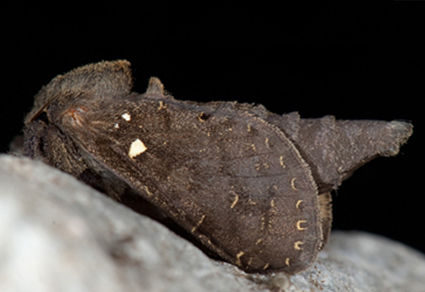Abstract
New Chinese Palpifer species are described from Yunnan and Fujian provinces. The male of Palpifer nielseni sp. n. is described from specimens housed at the Witt Museum Weiden and the Zoologisches Forschungsmuseum Alexander Koenig, while a male of P. chui sp. n. and a male and female of Palpifer climoi sp. n., are described from specimens in the latter collection only. Specimens were originally part of the Franz Daniel collection, collected in 1934–1935 from elevations of 2,300 and 3,000 m. The new species are diagnosed primarily by differences in the male genitalia. The female genitalia of P. climoi sp. n. represent the second published description for Palpifer. Four unique features of the forewing supporting monophyly of Palpifer are discussed.
References
- Butler, A.G. (1879) Descriptions of new species of Lepidoptera from Japan. Annals and Magazine of Natural History, 23, 349–374. https://doi.org/10.1080/00222937908679847
- Chen, Y., Guo, S., Liu, Y., Ju, J. & Ren, J. (2017) Interannual variation of the onset of Yunnan’s rainy season and its relationships with the Arctic Oscillation of the preceding Winter. Atmospheric and Climate Sciences, 7, 210–222. https://doi.org/10.4236/acs.2017.72015
- Daniel, F. (1940) Die Cossidae und Hepialidae der ausbeuten Höne (Lep. Het.). Mitteilungen der Münchner Entomologischen Gesellschaft, 30, 1004–1024.
- Daniel, F. (1949) Die Cossidae und Hepialidae der ausbeuten Höne (Lep. Het.) (Nachtrag). Mitteilungen der Münchner Entomologischen Gesellschaft, 35–39, 226–230.
- Dumbleton, L.J. (1966) Genitalia, classification and zoogeography of the New Zealand Hepialidae (Lepidoptera). New Zealand Journal of Science, 9, 920–981.
- Grehan, J.R. & Ismavel, V.A. (2017) Forest ghost moth fauna of northeastern India (Lepidoptera: Hepialidae: Endoclita, Palpifer, and Hepialiscus). Journal of Threatened Taxa, 9, 9940–9955. https://doi.org/10.11609/jott.3030.9.3.9940-9955
- Grehan, J.R. & Mielke, C.G.C. (2019) Two new species of Palpifer Hampson, 1893 from South East Asia (Lepidoptera: Hepialidae). Bishop Museum Occassional Papers, 125, 1–23.
- Grehan, J.R. & Mielke, C.G.C. (2020) Taxonomic revision and biogeography of Phassodes Bethune-Baker, 1905 (Lepidoptera: Hepialidae), ghost moth descendants of a subduction zone weed in the South-West Pacific. Bishop Museum Occasional Papers, 136, 1–37.
- Grehan, J.R., Mielke, C.G.C., Basu, D.N., Negi, C.S., Sharma, P.K. & Kunte, K. (2021) New species of Thitarodes Viette, 1968 ghost moth from Kumaun Himalaya, India (Lepidoptera: Hepialidae). ZooNova, 12, 1–16.
- Hampson, G.F. (1893) The Fauna of British India, including Ceylon and Burma. Moths. Vol. I. Taylor and Francis, London, 527 pp.
- Karim, S. & Grehan, J.R. (2019) First records of the ghost moth genus Palpifer Hampson, [1893] (Lepidoptera: Hepialidae) from the Indian subcontinent south of the Himalaya. Journal of Threatened Taxa, 11, 14777–14779. https://doi.org/10.11609/jott.4955.11.13.14777-14779
- Matsumura, S.M. (1931) 6000 illustrated insects of the Japan-Empire. Toko Shoin, Tokyo, 1496 pp.
- Mielke, C.G.C. & Casagrande, M.M. (2013) A new Cibyra Walker, 1856 from southern Brazil with taxonomic notes (first note) (Lepidoptera, Hepialidae). Nachrichten des Entomologischen Vereins Apollo, Neue Folge, 34, 73–86.
- Moore, F. (1879) Descriptions of new genera and species of Asiatic Lepidoptera Heterocera. Proceedings of the Zoological Society of London, 1879, 387–417. https://doi.org/10.1111/j.1096-3642.1879.tb02671.x
- Nielsen, E.S. & Robinson, G..S. (1983) Ghost moths of southern South America (Lepidoptera: Hepialidae). Entomonograph, 4, 1–192
- Pfitzner, R. (1933) Familie: Hepialidae. In: Seitz, A. (Ed.), Die gross-schmetterlinge der Erde. 10. Spinner und schwärmer des Indo-Australischen gebiets. Verlag des Seitzschen Werkes (Alfred Kerne), Stuttgart, pp. 825–847.
- Snellen, P.C.T. (1900) s.n. In: Piepers, M.C. & Snellen, P.C.T. (Eds.), Énumeration des Lépidoptéres Hétérocères recueillis á Java. Tijdschrift voor Entomologie, 43, pp. 12–108, 4 pls.
- Viette, P. (1950) Contribution à l’étude des Hepialidae (22e note). Hepialidae du Musée de Leiden. Zoologische Mededelingen, 31, 67–77.
- Viette, P. (1968) Contribution à l’étude des Hepialidae (36e note). Lepidoptera Hépialidaé du Népal. Ergebnisse Forsch Unternehmens Nepal Himalaya/Khumbu Himal, 3, 128–133.
- Zhao, L., Ma, C., Leipe, C., Long, T., Liu, K., Lu, H., Tang, L., Zhang, Y., Wagner, M. & Tarasov, P.E. (2017) Holocene vegetation dynamics in response to climate change and human activities derived from pollen and charcoal records from southeastern China. Palaeogeography, Palaeoclimatology, Palaeoecology, 485, 644–660. https://doi.org/10.1016/j.palaeo.2017.06.035


